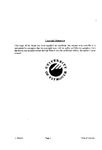Investigation into the control of an upper-limb myoelectric prosthesis
| dc.contributor.author | Roberts, Steven Michael | |
| dc.contributor.other | Faculty of Science and Engineering | en_US |
| dc.date.accessioned | 2011-06-28T14:17:30Z | |
| dc.date.available | 2011-06-28T14:17:30Z | |
| dc.date.issued | 2002 | |
| dc.identifier | Not available | en_US |
| dc.identifier.uri | http://hdl.handle.net/10026.1/505 | |
| dc.description.abstract |
This thesis presents research that extends current knowledge in the area of upper-limb prosthesis design and control. A study of myoelectric signals (MES)'s using both NHS and other equipment has resulted in identification of the signal source and transmission/detection issues. A globally comprehensive and up to date survey of myoelectric research has revealed new and long-term research paths. This thesis challenges the old model in interpreting the MES signals by providing and collecting evidence to suggest a new approach to future investigation. The historical description of a stochastic, non-deterministic MES has been shown by this research to be incomplete. An expanded, more detailed physiological description of the ME S has been presented as an improved MES model in Chapter 7 and demonstrates that it is possible to separate the deterministic and the stochastic elements of the MES. An original extensive list of variables underlines the deterministic nature of the MES. This research has used an original controlled mapping technique for surface MES's that have revealed unique spectral features for muscle actions. The feature selection and analysis and pattern recognition of the MES has been of fundamental importance to the advancement of prosthesis functionality. Spectral analysis of the MES along with exponential averaging has produced signal identification of potential high reliability and high repeatability A phenomenon, "the Tissue Filter Function" (TFF), has been considered, in past research, as an undesirable consequence of the passage through tissue, of the muscle-generated signal. This TFF shows itself as a frequency shift between at least two signals that are observed at a single electrode site and has shown itself, in this work, to be a previously unused identification feature. An original simplified geometry model of the hand has been devised which greatly improves prosthesis dexterity while minimising the requirement for the many degrees of freedom of the human hand. An original approach proposed is the use of 3 to 4 distinct very narrow band-pass channels in the frequency-domain, signal transient-region as detected by multiple site electrodes (4 or more sites proposed). This data is then in a form suitable to be presented to a Neural Network (NN) pattern recognition tool. This research has shown that the probability is high that the cross coupling between a set of (4) surface electrodes will detect these frequency shifted signals throughout the 3-dimensional medium of an amputee upper forearm. | |
| dc.language.iso | en | en_US |
| dc.publisher | University of Plymouth | en_US |
| dc.title | Investigation into the control of an upper-limb myoelectric prosthesis | en_US |
| dc.type | Thesis | |
| dc.identifier.doi | http://dx.doi.org/10.24382/3543 |
Files in this item
This item appears in the following Collection(s)
-
01 Research Theses Main Collection
Research Theses Main


